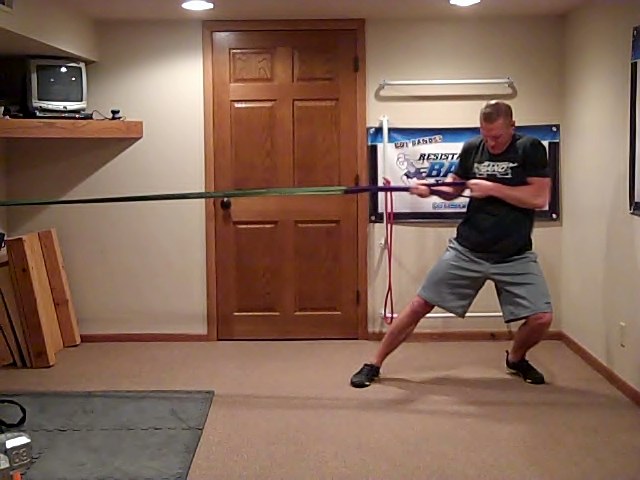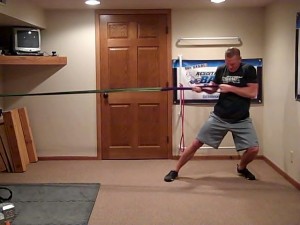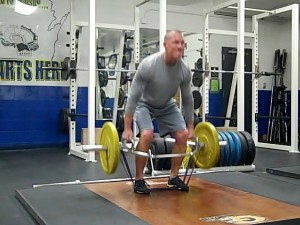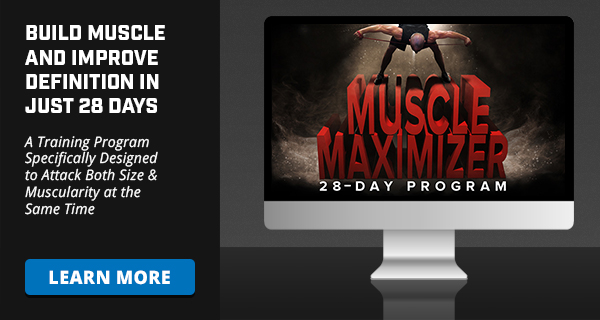Training with Both Bands and Weights
Yes, I am a Band GUY and yes, I am very passionate about the importance of incorporating flat, continuously looped bands into all workouts, but I also understand the importance of incorporating body weight and free weight training into my personal and adult fitness workouts.
Why Not Use Both?
From a strength and conditioning standpoint, resistance bands achieve what free weights can’t but that doesn’t mean free weights are wrong or bad for you.
Last time I looked, we still have to overcome gravity every day we wake up and lifting a gravity dependent dead weight is still one of the best ways to get stronger against gravity and build lean muscle.
I want to discuss why combining flat, continuously looped, resistance band training with free weight resistance training will provide the body with what could be the perfect strength training approach. This is regardless of if your goal is to get stronger, shed unwanted fat, increase lean muscle or improve your athleticism.
Why You Should Train with Resistance Bands and Weights
Improving Movement Quality to Achieve Better Muscle Recruitment
We know that the better the quality of movement, the better the muscle recruitment. Very often movement is compromised when performing free weight training in order to complete the movement. We all know compensation leads to injury, and unnecessary joint and muscle pain. With bands, the resistance can be increased or decreased instantly by adjusting the starting stretch tension.
Many individuals like performing an auxiliary type band exercise after doing a primary free weight exercise. This is a great way to combine bands and weights for muscle growth and definition. By using what is known as a “super-set” training technique, it maximally fatigues the muscle while still performing a quality movement pattern but not placing the joints at risk of overuse injury.
Workout Example: Performing a bench press set or workout followed by a band resisted, standing chest press routine or assisted push-up routine where perfect reps are the goal.
Improving Power
Life is really all about creating power or being able to create “quick strength”. Free weights, without a doubt, are the best option at developing absolute strength but that typically is seen as slow strength movements. Bands on the other hand, allow you to change the speed of movement and actually accelerate movement which is more consistent with how power is increased.
Therefore, by combining aggressive, free weight absolute strength training, using heavier weights and low reps—with higher velocity band resistance training for low reps and a moderate resistance—an individual can teach the body how to generate force faster which is exactly how power, not just strength, is increased. In the real world, being able to generate strength quickly, versus slowly, is far more important at keeping our body healthy and functioning at a high level.
Workout Example: Combining barbell push presses and band jerk presses.
Creating Long and Strong Muscles
Very often when lifting weights, range of motion is restricted due to the movement or the inability to lift the weight through a full range of motion. By adding in a band while performing a free weight movement or following up a free weight movement with a similar band resisted exercise, you allow the muscle to be maximally lengthened during the eccentric movement. This ensures the muscle does not lose flexibility which can happen if using only free weights.
By doing this, it not only improves flexibility but will also improve the body’s ability to load off the muscle prior to a concentric contraction occurring which will make the muscle contract better and work more efficiently.
Workout Example: Performing barbell or dumbbell bent over rows and following that with band squat rows.
Also keep in mind that bands are a tremendous pre-workout stretching tool that allows individuals to optimally prepare their muscles and joints for high intensity, full range of motion strength training.
Strengthen Full Range of Motion
A free weight resistance is a constant resistance that causes different levels of muscle recruitment based on where the resistance is being applied within the range of motion. As a result, in most free weight exercises the muscle is working harder at the beginning and in the mid-range of the movement versus at the end of the concentric movement.
With an ascending band resistance, the work effort of the muscle is going to increase as range of motion increases. Therefore, by training with bands and weights the muscle is getting maximally challenged throughout the entire range of motion.
Workout Example: Performing heavy squat training and the following workout doing more band related, squat training like front squats, split squats or reverse lunges.
When Lifting Weights is No Longer an Option
Band resistance training is more joint friendly for several reasons. Therefore, incorporating only band resistance workouts periodically during a training program provides the muscle an opportunity to recover and ultimately become stronger due to enhanced recovery.
Also, for those individuals that have lifted weights for years and can no longer lift weights due to significant joint or tendon pain, band training provides them with an option to keep their muscles strong and well defined.
What’s also interesting is that for those individuals that performed a band resistance training only program for an extended period of time, they frequently reported back that they were able to return back to free weight resistance training again without the reoccurring joint or tendon pain.
Develop Reactive not Just Isometric Joint Stability
Isometric stabilization is critical to lifting heavy free weight resistance. However, with day to day function, being dynamically or re-actively stable becomes far more important to keeping joints, cartilage and soft-tissues healthy.
By training with bands and weights, it teaches the body to be both isometrically and dynamically stable anywhere throughout the range of motion, therefore keeping joints safe no matter what the movement challenge may be.
Workout Example: Training barbell squats and combining that with resisted band step lunges or quick step drills using a horizontal vector and a 3-inch box.
Develop 3-D Strength
It’s well understood that the body is multi-planar when it comes to muscle structure and function. Free weight training is essentially limited to training in a single plane whereas resistance bands allow the body to train in multiple planes.
It is also well understood that a muscle is only as strong as its weakest point or plane. By training with bands and weights, it allows the body to become optimally strong in all planes which I refer to as 3-D strength.
By optimizing strength in the weakest plane, it will allow the strength in the strongest plane to increase. From a weight lifter perspective, band training in different planes and using different vector will increase your strength of primary movements.
Workout Example: Performing barbell dead lifts with horizontal, vector band rotational pulls to improve hip stability in the frontal and transverse plane.
Summary
Training with bands and weights does not have to be mutually exclusive. Instead, by combining band resistance training with free weight or body weight resistance training, it allows the body to optimize strength while improving key components of function that would not occur if training with free weights only.
Related Posts
Attaching Bands to the Body – Learn How
Band Training for Hybrid Olympic Lifts
Contrast Band Training – What is It?
Looking For a Way to Build Muscle AND Increase Definition?
Try our 28-day program, Muscle Maximizer and get access to a 5-day split routine that will help you look both, stronger and more tone.
Click Image to Learn More



